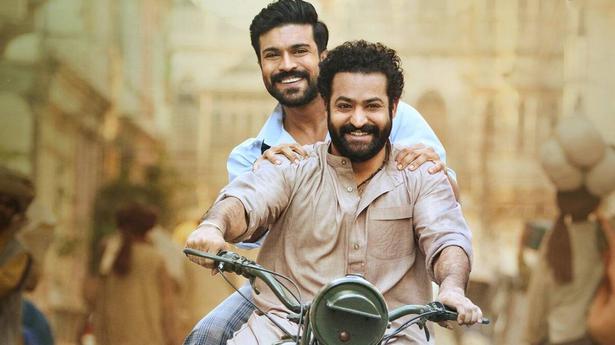Navia Natrajan presenting ‘Nāmayāchi Jani’.
| Photo Credit: Amarnath AL
‘Nāmayāchi Jani – The Songs of the Stonemill’, a unique collaboration between a dhrupad ensemble and a Bharatanatyam dancer, was recently presented before a packed house at the Bangalore International Centre.
Navia Natarajan presenting ‘Nāmayāchi Jani’.
| Photo Credit:
Amarnath AL
Conceptualised by Janhavi Phansalkar and presented by Sunaad, it was a show filled with apparent contradictions; ‘apparent’ being key. The expectation may have been of a simple biographical depiction of the 13th century Marathi saint-poet Janābāi’s life through music and dance. The endeavour was clearly far more ambitious. And yet, it did not seem like a conscious ambition at play but rather, an effortless outcome of a sustained engagement.
The majestic grandeur of the final presentation was no simple feat; and that’s where the (apparent) contradictions began. Though the setting of the stage was such that the dancer used most of the visible space, it did not come across as a solo Bharatanatyam show. Navia Natarajan, the choreographer and dancer, came up with a masterful portrayal of Janābāi — coasting through mundane household chores, totally immersed in her love and devotion for Vitthala. A love that was so strong that the lord himself was physically pulled to be with her, partake in the joys, and ease the burden of her daily life.
From ‘Nāmayāchi Jani’.
| Photo Credit:
Amarnath AL
Navia skillfully meandered through the complexities of Jani’s interactions with the people around her, who weren’t ready to comprehend a love and devotion so pure. We were able to witness the simplicity and magnificence of Jani’s evolving relationship with Vitthala, guided by her Guru Nāmdev sometimes, and Vitthala himself at others.
Despite Navia’s enrapturing performance, she managed to deftly slip away from the spotlight — both literally and figuratively, when needed. This allowed an effective absorption of the ideas and thought, without being ‘distracted’ by the performance. It takes an artiste of high maturity to pull off something like this; and thus, the contradictions continue. When one hears Janābāi, one thinks abhang. This show featured several of them.
Navia Natrajan along with the music ensemble presenting ‘Nāmayāchi Jani’.
| Photo Credit:
Amarnath AL
This project was birthed when Janhavi, a talented dhrupad musician, decided to compose abhangs in the dhrupad genre. She (with her extensive training in dhrupad and khayal, and a long exposure to the Varkari tradition) managed to carve a whole new aesthetic for a musical exploration of abhang. The show featured a captivating sound design. Gentle alaps, expertly composed in a variety of rāags and mixed with dynamic phrases overlaid with novel rhythmic arrangements on the pakhawaj, were a delight. The abhangs themselves were set to various rāags, and again complemented by novel percussive arrangements, which were done in collaboration with Dnyaneshwar Deshmukh, an established dhrupad-style pakhawaj artiste, who is also steeped in the Varkari tradition.
Navia Natrajan collaborated with a team of musicians to present ‘Nāmayāchi Jani’.
| Photo Credit:
Amarnath AL
The melodious voices of Janhavi and Dhani Gundecha, another excellent young dhrupad musician, rang through the auditorium, effectively carrying across the playful stillness of Jani’s devotion. The resounding pakhawaj sounds were provided by Dnyaneshwar along with Hirdesh Chopra. Complementing them on the nattuvangam was Surya Rao. This was neither a music, nor a dance show. The narrators played an integral role in the entire performance. The listener could choose to revel in the simplicity of the narrative of Jani’s tale, or dive into the depths of the philosophy. The narration was intelligently designed to develop Jani’s story and philosophy even while presenting the translation of the abhangs. The crisp articulation by Pratibha Panth and Chinthu Param enhanced the presentation.
Having established the apparent contradictions, the show also managed to dissolve the differences. Much like how the Sagun and Nirgun shades of bhakti merged into one, the different art forms blended into one common expression. It managed to bring across the simplicity and beauty of complex ideas. There was something for everyone. The spectators’ standing ovation was probably the final contradiction of the evening — the introspective stillness facilitated by the performance eventually outweighed by the spontaneous outward expression of heartfelt appreciation.





